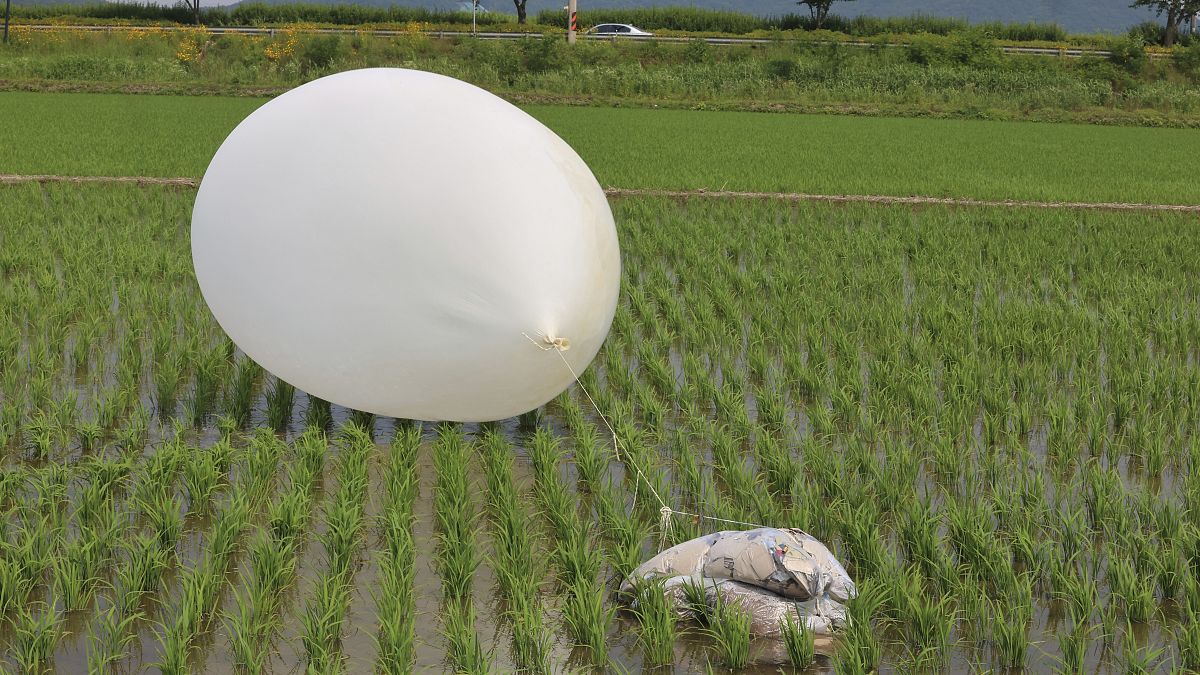Pyongyang and Seoul are exchanging increasingly heated rhetoric as Kim Jong-un expands his military cooperation with Russia.
Trash carried by a North Korean balloon has fallen on the presidential compound in central Seoul on Thursday for the second time, raising concerns about the vulnerability of key South Korean sites.
According to South Korea’s presidential security service, no dangerous items were found in the waste that was released when one of the North Korean balloons burst over the presidential compound on Thursday morning.
The incident comes after the rival Koreas ramped up threats and rhetoric against each other, with the north claiming that the south flew drones over Pyongyang earlier this month to scatter propaganda leaflets.
North Korea has sent thousands of balloons carrying assorted plastic and paper waste but no hazardous materials into South Korean airspace since late May, a return to Cold War-era psychological tactics. The trash that fell on the South Korean presidential compound in July also contained no dangerous items.
It wasn’t immediately known whether South Korean President Yoon Suk-yeol was at the compound when the latest balloon dropped its payload. He met with visiting Polish President Andrzej Duda as planned later the same day.
South Korean media have reported that on Thursday, North Korean leaflets criticising Yoon and his wife Kim Keon-hee were found in the Yongsan district of Seoul, where Yoon’s presidential office is located.
Outlets published photos of some of leaflets describing the president’s wife as a latter-day Marie Antoinette.
Local media said it was the first time North Korean leaflets have been found in South Korea since the balloon campaign began some five months ago.
The South Korean presidential security service has yet to confirm the reports specifically, but South Korea’s Joint Chiefs of Staff have urged North Korea to stop dropping “crude leaflets” slandering the president — and have warned that Pyongyang will be entirely responsible for any consequences.
However, experts say North Korea is unlikely to possess the sophisticated technology that would be needed to drop balloons on specific targets.
“Whether the balloons have GPS or not, it’s all about launching them in large numbers and hitting the right altitude based on wind direction and speed, so that they can ride those winds to travel,” said Lee Choon-geun, an honorary research fellow at South Korea’s Science and Technology Policy Institute.
“While some media are saying the accuracy of the balloons has improved, that improved accuracy isn’t because they equipped them with some sort of guidance system, but rather because it’s the season when winds blow southward.”
Tit-for-tat reprisals
North Korea has accused South Korea of using drones to drop propaganda leaflets over Pyongyang three times in the last month and has threatened reprisals if it happens again.
Seoul has refused to confirm whether the accusation is grounded in fact, instead warning that North Korea would face the end of its regime if the safety of South Korean citizens is threatened.
North Korea said its balloon activities were retaliation against the actions of South Korean activists who launched anti-Kim leaflets toward Pyongyang attached to balloons of their own.
South Korea has responded to the trash balloons by restarting propaganda broadcasts from loudspeakers positioned at border areas — prompting North Korea to turn its own frontline loudspeakers back on.
Kim Jong-un has lately been increasing the pace of his weapons tests, and has greatly expanded his country’s overt military cooperation with Russia.
US and South Korean officials said on Wednesday that some 3,000 North Korean troops are now training in several locations in Russia. According to South Korea, Pyongyang eventually aims to send a total of 10,000 troops to Russia to support the ongoing invasion of Ukraine, which has badly depleted Russia’s forces.
South Korea is concerned that Russia may reward North Korea for its contribution with sophisticated technological contributions to its nuclear and ballistic missile programs, both of which are targeted at South Korea and the US.

